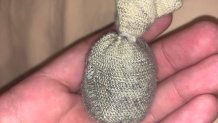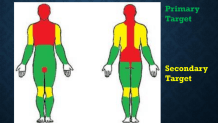As throngs of protesters have gathered in cities throughout San Diego County to demonstrate against the death of George Floyd, local law enforcement agencies have turned to the use of bean bag projectiles, referred to broadly as rubber bullets, to thwart the unrest.
And while the bean bag rounds are considered non-lethal options for police, there are now numerous reports of demonstrators suffering serious, potentially life-threatening, injuries from the use of the projectiles. Two protestors in La Mesa were hit in the head with bean bag rounds in La Mesa during a May 30 demonstration, one of which was a 59-year-old grandmother who may lose an eye and is now in stable condition at a nearby hospital.

The other is 18-year-old Tyler Astorga who, according to his attorney Dante Pride, yelled an obscenity at police while driving through the protest near the Chase Bank which was set on fire in La Mesa. Pride and his law firm represents dozens of protestors on a pro-bono basis who say they were injured or unfairly arrested during the protests. 18-year-old Tyler Astorga is one.
“The officer was standing like ten feet away from me when he shot me,” Astorga told NBC 7 Investigates during a June 3 conversation.

Astorga said that a doctor later told him he would have likely died if he was looking the other way.

But as the use of the non-lethal ammunition increases, so too do questions regarding the use and training of the non-lethal shotgun projectiles.
Local
According to law enforcement training handbooks, a single bean bag round fired from a 12-gauge shotgun travels between 200-300 feet per second and are meant to inflict blunt force trauma to a person.
A 2017 study in BMJ Open Medical Journal found that deaths and permanent injuries from getting shot by non-lethal projectiles have occurred. The study found 3 percent of those hit died in the data researchers used for the article and 15 percent of those shot suffered permanent injuries. People hit in the head and neck accounted for half of the deaths examined in the study.
Because of the potential lethality, law enforcement personnel, including officers in La Mesa, San Diego, and cities throughout the county, are trained to aim below the waist.

But as Dr. Ranit Mishori, a professor of medicine at Georgetown University and medical advisor for Physicians for Human Rights, says police officers are using the plastic artillery much too often and much too fast.
“These are often referred to as cramped crowd control weapons, and they're thought of as non-lethal, but they're or anything but,” said Dr. Mishori. “When it's used above the waist, it can cause very severe damage and even lead to death. So, the non-lethal moniker that's attached to this group of weapons is inaccurate. In fact, these weapons are not non-lethal, they're not benign, and they can definitely cause serious harm and death.”
Mishori says police, military, or any law enforcement agency should use these methods as a last resort, and not as a tool to disperse crowds.
“When everything else fails, when all other deescalation tactics fail, when there are imminent threats to the local, um, Population to the military, to journalists, to medics only then is it okay to use these weapons, but really they are weapons of last resort.”
But as seen at protest sites throughout San Diego and the nation, police have used a variety of non-lethal weapons to dispel crowds including flash bangs, tear gas, as well as rubber and bean bag projectiles.
“The fact that they are now being used in the current circumstances on peaceful crowds is appalling and excessive,” added Mishori. “We are talking about people, people who are generally speaking peaceful, they have a right to peaceful assembly.”
However, law enforcement experts say there are few options at the disposal of those trying to keep the peace in oftentimes chaotic situations.
Charles “Sid” Heal is a retired Sheriff’s Commander for the Los Angeles Sheriff’s Department. Heal has instructed officers and police departments on tactical operations and the use of non-lethal weapons since the late 1980’s.
Heal agrees that training can be improved but he also says the lack of options is the main reason for the increased use of non-lethal ammunition..
The target area from all distances should be the lower girdle area of the subject. This would include the lower abdominal region (belly button area) and below. Generally, the head, neck, thorax, heart, and spine area should not be targeted.
Retired Sheriff Commander Charles Heal teaches the use of non-lethal weapons by law enforcement officers.
“The face, the throat, the armpit, the groin, are places that we avoid shooting at,” said Heal. “But, these are moving targets under combative conditions.
And while Heal says that the bean bag rounds are among the most effective at deescalating combative situations, he agrees that law enforcement agencies across the nation can do better at training.
“There's no common nomenclature. There's no standards for training,” said Heal. “It's frustrating for those of us who have been in the field. We are having the same discussions in 2020 that we were having in 1995 and we don't like him either. But that doesn't make the problem go away for us.”
Added Heal, “They are effective. People are throwing bricks at us, and even a third of a brick can kill you at about 55 yards. We go to great lengths to avoid them, but my response would be, so what do you want me to do? You've given me this tremendously complex and dangerous problem to resolve, and virtually nothing to resolve it with except lethal force.”
NBC 7 Investigates reached out to La Mesa Police Department for comment on their use of bean bag rounds. The city and it’s police department declined to comment for the article.



